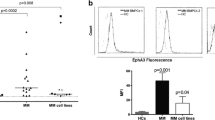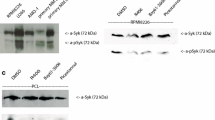Abstract
Homoharringtonine (HHT) is a known anti-leukemia drug that inhibits multiple myeloma (MM) cells both in vitro and in vivo. Our prior study demonstrated that the potency of HHT in MM cells was compromised significantly when myeloma cells were co-cultured with BM stromal cells. This study aimed to investigate whether PI3K/Akt inhibitor LY294002 could potentiate the antimyeloma activity of HHT against MM cells adhered to BM stromal cells and in vivo xenograft models. A co-culture system composed of MM cells and human stromal cells was employed to mimic MM cells in bone marrow niche. The inhibitory and pro-apoptotic effect of HHT and LY294002 was determined by CCK-8 assay or flow cytometry. Expression of PI3K/Akt signaling molecules and anti-apoptotic protein myeloid cell leukemia-1 (Mcl-1) was assessed by western blot analysis and/or reverse transcription real-time quantitative PCR (RT-qPCR). MM xenografts were used to evaluate antitumor effect of combined therapy with HHT and LY294002. Adhesion to BM stromal cells rendered MM cells resistant to HHT whereas silencing Mcl-1 partly reversed the resistance. LY294002 induced apoptosis in MM cells and potentiated the antimyeloma effects of HHT by inhibiting the PI3K/Akt signal pathway which was abnormally activated during adhesion. LY294002 also enhanced the antimyeloma effect of HHT in in vivo xenograft models. These findings suggest that activation of PI3K/Akt signal pathway was responsible for the resistance to HHT in MM cells adhered to stromal cells. LY294002 can potentiate the antimyeloma activity of HHT both in vitro and in vivo, which may represent a new clinical treatment in MM.






Similar content being viewed by others
References
Kyle RA, Rajkumar SV (2004) Multiple myeloma. N Engl J Med 351(18):1860–1873. https://doi.org/10.1056/NEJMra041875
Dispenzieri A, Kyle RA (2005) Multiple myeloma: clinical features and indications for therapy. Best Pract Res Clin Haematol 18(4):553–568. https://doi.org/10.1016/j.beha.2005.01.008
Ria R, Catacchio I, Berardi S, De Luisi A, Caivano A, Piccoli C, Ruggieri V, Frassanito MA, Ribatti D, Nico B, Annese T, Ruggieri S, Guarini A, Minoia C, Ditonno P, Angelucci E, Derudas D, Moschetta M, Dammacco F, Vacca A (2014) HIF-1alpha of bone marrow endothelial cells implies relapse and drug resistance in patients with multiple myeloma and may act as a therapeutic target. Clin Cancer Res 20(4):847–858. https://doi.org/10.1158/1078-0432.ccr-13-1950
Hao M, Zhang L, An G, Meng H, Han Y, Xie Z, Xu Y, Li C, Yu Z, Chang H, Qiu L (2011) Bone marrow stromal cells protect myeloma cells from bortezomib induced apoptosis by suppressing microRNA-15a expression. Leuk Lymphoma 52(9):1787–1794. https://doi.org/10.3109/10428194.2011.576791
Wang J, Hendrix A, Hernot S, Lemaire M, De Bruyne E, Van Valckenborgh E, Lahoutte T, De Wever O, Vanderkerken K, Menu E (2014) Bone marrow stromal cell-derived exosomes as communicators in drug resistance in multiple myeloma cells. Blood 124(4):555–566. https://doi.org/10.1182/blood-2014-03-562439
Warrell RP Jr, Coonley CJ, Gee TS (1985) Homoharringtonine: an effective new drug for remission induction in refractory nonlymphoblastic leukemia. J Clin Oncol 3(5):617–621. https://doi.org/10.1200/jco.1985.3.5.617
Luo CY, Tang JY, Wang YP (2004) Homoharringtonine: a new treatment option for myeloid leukemia. Hematology 9(4):259–270. https://doi.org/10.1080/10245330410001714194
Meng H, Yang C, Jin J, Zhou Y, Qian W (2008) Homoharringtonine inhibits the AKT pathway and induces in vitro and in vivo cytotoxicity in human multiple myeloma cells. Leuk Lymphoma 49(10):1954–1962. https://doi.org/10.1080/10428190802320368
Lou YJ, Qian WB, Jin J (2007) Homoharringtonine induces apoptosis and growth arrest in human myeloma cells. Leuk Lymphoma 48(7):1400–1406. https://doi.org/10.1080/10428190701411466
Yang X, Yang C, Shao K, Ye X, Meng H, Zhou Y, Qian W (2007) Refractory multiple myeloma treated with homoharringtonine: report of two cases. Ann Hematol 86(12):919–921. https://doi.org/10.1007/s00277-007-0331-5
Zhang B, Gojo I, Fenton RG (2002) Myeloid cell factor-1 is a critical survival factor for multiple myeloma. Blood 99(6):1885–1893. https://doi.org/10.1182/blood.V99.6.1885
Chen R, Guo L, Chen Y, Jiang Y, Wierda WG, Plunkett W (2011) Homoharringtonine reduced Mcl-1 expression and induced apoptosis in chronic lymphocytic leukemia. Blood 117(1):156–164. https://doi.org/10.1182/blood-2010-01-262808
Wang WL, Zhang YC, Zeng HM, Hua CL, Wei W, Xu J, Zhu XF, Cheng T, Yuan WP (2012) Regulatory mechanisms of PI3K/AKT signaling pathway in acute leukemia. J Exp Hematol 20(1):18–21
Chen P, Huang H, Wu J, Lu R, Wu Y, Jiang X, Yuan Q, Chen Y (2015) Bone marrow stromal cells protect acute myeloid leukemia cells from anti-CD44 therapy partly through regulating PI3K/Akt-p27(Kip1) axis. Mol Carcinog 54(12):1678–1685. https://doi.org/10.1002/mc.22239
Shi Y, Yan H, Frost P, Gera J, Lichtenstein A (2005) Mammalian target of rapamycin inhibitors activate the AKT kinase in multiple myeloma cells by up-regulating the insulin-like growth factor receptor/insulin receptor substrate-1/phosphatidylinositol 3-kinase cascade. Mol Cancer Ther 4(10):1533–1540. https://doi.org/10.1158/1535-7163.mct-05-0068
Chen P, Jin Q, Fu Q, You P, Jiang X, Yuan Q, Huang H (2016) Induction of multidrug resistance of acute myeloid leukemia cells by cocultured stromal cells via upregulation of the PI3K/Akt signaling pathway. Oncol Res 24(4):215–223. https://doi.org/10.3727/096504016x14634208143021
Cao H, Zhu K, Qiu L, Niu H, Hao M, Yang S, Zhao Z, Lai Y, Anderson JL, Fan J, Im HJ, Chen D, Roodman GD, Xiao G (2013) Critical role of AKT protein in myeloma-induced osteoclast formation and osteolysis. J Biol Chem 288(42):30399–30410. https://doi.org/10.1074/jbc.M113.469973
Fujiwara M, Izuishi K, Sano T, Hossain MA, Kimura S, Masaki T, Suzuki Y (2008) Modulating effect of the PI3-kinase inhibitor LY294002 on cisplatin in human pancreatic cancer cells. J Exp Clin Cancer Res 27(1):76. https://doi.org/10.1186/1756-9966-27-76
Lee JH, Kim C, Kim SH, Sethi G, Ahn KS (2015) Farnesol inhibits tumor growth and enhances the anticancer effects of bortezomib in multiple myeloma xenograft mouse model through the modulation of STAT3 signaling pathway. Cancer Lett 360(2):280–293. https://doi.org/10.1016/j.canlet.2015.02.024
Chang H, Qi C, Yi QL, Reece D, Stewart AK (2005) p53 gene deletion detected by fluorescence in situ hybridization is an adverse prognostic factor for patients with multiple myeloma following autologous stem cell transplantation. Blood 105(1):358–360. https://doi.org/10.1182/blood-2004-04-1363
Feldman E, Arlin Z, Ahmed T, Mittelman A, Puccio C, Chun H, Cook P, Baskind P (1992) Homoharringtonine in combination with cytarabine for patients with acute myelogenous leukemia. Leukemia 6(11):1189–1191
Feldman EJ, Seiter KP, Ahmed T, Baskind P, Arlin ZA (1996) Homoharringtonine in patients with myelodysplastic syndrome (MDS) and MDS evolving to acute myeloid leukemia. Leukemia 10(1):40–42
O'Brien S, Kantarjian H, Keating M, Beran M, Koller C, Robertson LE, Hester J, Rios MB, Andreeff M, Talpaz M (1995) Homoharringtonine therapy induces responses in patients with chronic myelogenous leukemia in late chronic phase. Blood 86(9):3322–3326
Chen P, Yuan Q, Yang H, Wen X, You P, Hou D, Xie J, Cheng Y, Huang H (2017) Homoharringtonine enhances bortezomib antimyeloma activity in myeloma cells adhesion to bone marrow stromal cells and in SCID mouse xenografts. Leuk Res 57:119–126. https://doi.org/10.1016/j.leukres.2017.04.007
Funding
This research is granted by the Fujian Provincial Innovation Fund (2014-CX-13), Fujian Provincial Natural Fund (2015J01472), Fujian Medical University Professor Fund (JS14024), Personnel Training Program of Fujian Provincial Health System for Youth Backbone Talents (2014-ZQN-JC-10), Construction Project of Fujian Medical Center of Hematology (Min201704), and National and Fujian Provincial Key Clinical Specialty Discipline Construction Program, P. R. C.
Author information
Authors and Affiliations
Corresponding author
Ethics declarations
Primary MM cells were isolated from the patients in the Fujian Medical University Union Hospital with informed consent and institutional review board approval. The use of animals was approved by the Committee of Research Animals of Fujian Medical University.
Conflict of interest
The authors declare that they have no conflict of interest.
Rights and permissions
About this article
Cite this article
Chen, P., Wen, X., Wang, B. et al. PI3K/Akt inhibitor LY294002 potentiates homoharringtonine antimyeloma activity in myeloma cells adhered to stromal cells and in SCID mouse xenograft. Ann Hematol 97, 865–875 (2018). https://doi.org/10.1007/s00277-018-3247-3
Received:
Accepted:
Published:
Issue Date:
DOI: https://doi.org/10.1007/s00277-018-3247-3




